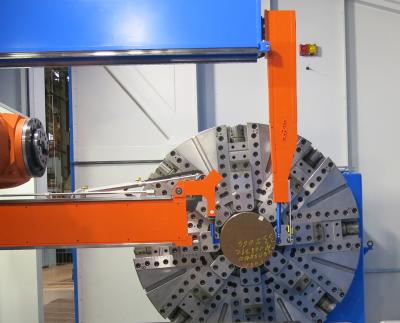
GEORG offers an integrated two-point measurement system for horizontal machining centers of its ultraturn MC series. These machines process workpieces weighing 10 tons and more and with diameters of 1,000 mm upwards.
With the two-point measurement, GEORG has for the first time integrated quality control directly into the manufacturing process: ultraturn MC is a series of machining centers for large turned parts in which the diameters of the workpiece are not measured with just one probe, as has been common practice so far. Instead, GEORG uses a travelling two-point measuring system attached to the frame, which automatically measures the workpieces directly in the machine with two opposing probes. This technique ensures high precision and high reproducibility.
ultraturn MC machines are used among other things for the complete machining of turbine and generator rotors, as well as crankshafts.
While a measuring team would need several hours to manually measure the diameters or the axial runout of workpieces on the machine, the measurement with the integrated two-point system is completed after just a few minutes. By integrating this function into the machine, GEORG is a worldwide pioneer.
The two-point measuring system is also applicable to the company’s classic lathe series for roll and turbine rotor machining. Furthermore, the system can be retrofitted to existing lathes made by GEORG or other manufacturers. Just recently, GEORG has successfully retrofitted a two-point measuring system to a lathe in operation for several years at Siemens in Mülheim/Germany.
Jan Ebener, sales manager for machine tools at GEORG, explains the economic benefits of the integrated measurement: “Experience gained from the operation of the first systems using our two-point measurement technique shows that not only the dimensional precision of the workpieces is increased but that also the overall machining times are markedly reduced. This is because the new measurement technique drastically reduces nonproductive times.”
Contact Details
Related Glossary Terms
- centers
centers
Cone-shaped pins that support a workpiece by one or two ends during machining. The centers fit into holes drilled in the workpiece ends. Centers that turn with the workpiece are called “live” centers; those that do not are called “dead” centers.
- lathe
lathe
Turning machine capable of sawing, milling, grinding, gear-cutting, drilling, reaming, boring, threading, facing, chamfering, grooving, knurling, spinning, parting, necking, taper-cutting, and cam- and eccentric-cutting, as well as step- and straight-turning. Comes in a variety of forms, ranging from manual to semiautomatic to fully automatic, with major types being engine lathes, turning and contouring lathes, turret lathes and numerical-control lathes. The engine lathe consists of a headstock and spindle, tailstock, bed, carriage (complete with apron) and cross slides. Features include gear- (speed) and feed-selector levers, toolpost, compound rest, lead screw and reversing lead screw, threading dial and rapid-traverse lever. Special lathe types include through-the-spindle, camshaft and crankshaft, brake drum and rotor, spinning and gun-barrel machines. Toolroom and bench lathes are used for precision work; the former for tool-and-die work and similar tasks, the latter for small workpieces (instruments, watches), normally without a power feed. Models are typically designated according to their “swing,” or the largest-diameter workpiece that can be rotated; bed length, or the distance between centers; and horsepower generated. See turning machine.
- quality assurance ( quality control)
quality assurance ( quality control)
Terms denoting a formal program for monitoring product quality. The denotations are the same, but QC typically connotes a more traditional postmachining inspection system, while QA implies a more comprehensive approach, with emphasis on “total quality,” broad quality principles, statistical process control and other statistical methods.
